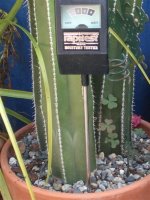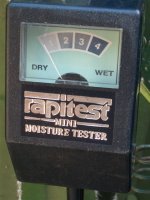
Fall is officially here, and although the weather in southern California doesn't appear to have changed significantly, there is now a slight dampness in the mornings and the evenings are definitely cooler. Watering
container plants in the summer is fairly simple, but now the days are not quite as hot it gets a bit more tricky, especially if you don't have a lot of time to examine each plant.

Many plants available now such as the
ornamental peppers shown here need to be kept evenly moist otherwise the leaves and the fruit quickly fall. However, slugs and other pests love that damp atmosphere, so check regularly around the base of the plant, especially if the plant begins to wilt. Sometimes they appear to need more water, when they are actually being eaten alive! If this happens, move the plant to a drier part of the garden and remove any dead leaves. Usually, once the pests are removed, the plant will come back.

The problem is, plants often droop and turn yellow if they are overwatered, and look similar to plants that have been underwatered. One of the simplest ways to test if a plant needs watering is to buy a
moisture tester. These inexpensive devices can be bought in gardening and most hardware stores and help cut the guesswork out of watering. They also come with a list of the most common plants and indicate whether the plant likes to be dry or needs more water.

These simple devices have a scale from dry to wet and are a crude way of testing the moisture in the soil. The surprising thing is that you soon learn how different the rate of water absorption is among different plants, so instead of watering all your plants with the same amount of water each day or every couple of days, it is often wise to water some and leave others. If you are still doubtful, most plants can usually survive a couple of days dry, but too much water often damages or kills the plant.
 Fall is officially here, and although the weather in southern California doesn't appear to have changed significantly, there is now a slight dampness in the mornings and the evenings are definitely cooler. Watering container plants in the summer is fairly simple, but now the days are not quite as hot it gets a bit more tricky, especially if you don't have a lot of time to examine each plant.
Fall is officially here, and although the weather in southern California doesn't appear to have changed significantly, there is now a slight dampness in the mornings and the evenings are definitely cooler. Watering container plants in the summer is fairly simple, but now the days are not quite as hot it gets a bit more tricky, especially if you don't have a lot of time to examine each plant. Many plants available now such as the ornamental peppers shown here need to be kept evenly moist otherwise the leaves and the fruit quickly fall. However, slugs and other pests love that damp atmosphere, so check regularly around the base of the plant, especially if the plant begins to wilt. Sometimes they appear to need more water, when they are actually being eaten alive! If this happens, move the plant to a drier part of the garden and remove any dead leaves. Usually, once the pests are removed, the plant will come back.
Many plants available now such as the ornamental peppers shown here need to be kept evenly moist otherwise the leaves and the fruit quickly fall. However, slugs and other pests love that damp atmosphere, so check regularly around the base of the plant, especially if the plant begins to wilt. Sometimes they appear to need more water, when they are actually being eaten alive! If this happens, move the plant to a drier part of the garden and remove any dead leaves. Usually, once the pests are removed, the plant will come back. The problem is, plants often droop and turn yellow if they are overwatered, and look similar to plants that have been underwatered. One of the simplest ways to test if a plant needs watering is to buy a moisture tester. These inexpensive devices can be bought in gardening and most hardware stores and help cut the guesswork out of watering. They also come with a list of the most common plants and indicate whether the plant likes to be dry or needs more water.
The problem is, plants often droop and turn yellow if they are overwatered, and look similar to plants that have been underwatered. One of the simplest ways to test if a plant needs watering is to buy a moisture tester. These inexpensive devices can be bought in gardening and most hardware stores and help cut the guesswork out of watering. They also come with a list of the most common plants and indicate whether the plant likes to be dry or needs more water. These simple devices have a scale from dry to wet and are a crude way of testing the moisture in the soil. The surprising thing is that you soon learn how different the rate of water absorption is among different plants, so instead of watering all your plants with the same amount of water each day or every couple of days, it is often wise to water some and leave others. If you are still doubtful, most plants can usually survive a couple of days dry, but too much water often damages or kills the plant.
These simple devices have a scale from dry to wet and are a crude way of testing the moisture in the soil. The surprising thing is that you soon learn how different the rate of water absorption is among different plants, so instead of watering all your plants with the same amount of water each day or every couple of days, it is often wise to water some and leave others. If you are still doubtful, most plants can usually survive a couple of days dry, but too much water often damages or kills the plant.



0 Comments:
Post a Comment
<< Home